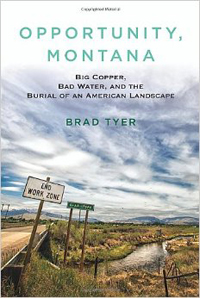Book Notes
 Brad Tyer, Opportunity, Montana: Big Copper, Bad Water, and The Burial of an American Landscape (Boston: Beacon Press, 2013), 232pp.
Brad Tyer, Opportunity, Montana: Big Copper, Bad Water, and The Burial of an American Landscape (Boston: Beacon Press, 2013), 232pp.
Brad Tyer was a seventh-generation Texan when he moved to Montana about ten years ago. He didn't know anything about the state except what you might see in coffee table books, so he expected nothing but "scenic superlatives." But then his job for the weekly Independent newspaper in Missoula opened his eyes to the state's many contradictions. It's a red-n-rural state with liberal enclaves, and a place where the locals are resentful of nonresidents who buy their massive ranches to fish in bubbly brooks.
As a journalist, Tyer investigated one of the state's most glaring contradictions. In addition to its "scenic superlatives," Montana is also home to one of the country's saddest environmental debacles. The story centers around the Clark Fork river, the biggest river in the state, which was dammed in 1908 and consequently became the dump site for a hundred years of industrial copper mining waste. Of course, these toxins poisoned the land, the water, the air, the wildlife, and the people, and in particular the tiny town called Opportunity and its population of 300–500 people.
There are 17 Superfund sites in Montana; by 1983 the EPA had designated the Clark Fork as the biggest and baddest. In the ensuing decades, and after hundreds of millions of dollars, the dam was removed and the river was "rebuilt." One question for any cleanup, though, is where to haul all the toxic waste that you excavate from the contaminated site. Opportunity was the destination for 3–4 million cubic yards of mining sludge, courtesy of the Anaconda Copper Company's work there from 1910 to 1972. As Tyer writes, "The copper that wired America had a price, and Opportunity paid it." It paid twice — once with the original contamination, then as the destination for the larger area's cleanup waste.
Tyer's book is part memoir and part environmental elegy. It's a carefully researched case study with no easy answers. "Environmental justice," he writes, "is an ethical inquiry into the equitable distribution of burdens — things like four-thousand-acre plots of toxic waste — resulting from endeavors that produce waste, which is to say industrial economies." Anaconda and ARCO made their millions if not billions. Politicians preened. The lawyers lawyered. The government was feckless. The world got its copper. Environmental experts and groups haggled. The citizens complained. And in the end, Opportunity paid for it all with an environmental death sentence.


